
Dec . 12, 2024 05:23
Back to list
coalescing filter
Understanding Coalescing Filters Key Concepts and Applications
In the realm of fluid mechanics and engineering, the efficiency and quality of fluid separation processes are crucial. One innovative solution that has gained traction in various industries is the coalescing filter. This specialized filter is designed to enhance the separation of emulsified liquids, particularly oil and water. It does so by promoting the coalescence of smaller droplets into larger ones, allowing for easier removal and cleaner output.
How Coalescing Filters Work
Coalescing filters operate on a fundamental principle the aggregation of small particles or droplets. These filters typically consist of a series of media that facilitate the collision and merging of droplets suspended in a fluid. As the emulsified liquid passes through the filter, the coalescing media encourages the tiny droplets to combine, forming larger droplets. This process is often accompanied by a reduction in turbulence, further aiding in the separation of the liquid phases.
The design of coalescing filters can vary, but they are generally comprised of three main components the pre-filter, the coalescing media, and the final filter. The pre-filter removes larger particles, allowing for a smoother flow and reducing wear on the coalescing media. The coalescing media is engineered to promote droplet aggregation, while the final filter captures any remaining particulate matter, ensuring that the output fluid meets the required purity standards.
Applications of Coalescing Filters
Coalescing filters find applications across multiple industries, from oil and gas to food processing and wastewater treatment. In the oil and gas sector, for instance, these filters play a pivotal role in separating water from crude oil. This is crucial for optimizing oil recovery and minimizing the environmental impact of operations. By ensuring that the extracted oil is as free from water as possible, coalescing filters contribute significantly to the efficiency and profitability of oil production.
coalescing filter

In the food industry, coalescing filters are utilized to refine edible oils by removing unwanted moisture and contaminants
. This enhances the quality and shelf-life of the oil, making it more suitable for culinary applications. Additionally, in wastewater treatment, these filters are essential for reducing the oil content in wastewater effluents, thereby aiding compliance with environmental regulations and promoting sustainability.Advantages of Coalescing Filters
The benefits of coalescing filters are manifold. Firstly, they are highly efficient in separating emulsified liquids, achieving significantly better results than traditional filtration methods. This translates to lower operating costs and reduced maintenance, as the need for frequent filter replacement is diminished.
Furthermore, coalescing filters often help in conserving energy. By facilitating smoother flow and reducing pressure drops in fluid systems, these filters can lower the overall energy consumption of the process. This not only leads to cost savings but also contributes to a lower carbon footprint for industrial operations.
Moreover, the versatility of coalescing filters allows them to be tailored to specific applications. They can be designed with varying pore sizes and materials to optimize performance based on the liquid's composition and the desired output quality. This customization makes them an invaluable tool across different sectors.
Conclusion
In summary, coalescing filters represent a significant advancement in the field of fluid separation technology. By promoting the coalescence of small droplets, they enhance the efficiency of processes across various industries, from oil and gas extraction to food processing and environmental management. Their ability to deliver cleaner outputs while reducing energy consumption and operational costs highlights their growing importance in modern engineering practices. As industries continue to prioritize efficiency and sustainability, coalescing filters will undoubtedly play a crucial role in shaping the future of fluid management.
Next:
Latest news
-
Safety Valve Spring-Loaded Design Overpressure ProtectionNewsJul.25,2025
-
Precision Voltage Regulator AC5 Accuracy Grade PerformanceNewsJul.25,2025
-
Natural Gas Pressure Regulating Skid Industrial Pipeline ApplicationsNewsJul.25,2025
-
Natural Gas Filter Stainless Steel Mesh Element DesignNewsJul.25,2025
-
Gas Pressure Regulator Valve Direct-Acting Spring-Loaded DesignNewsJul.25,2025
-
Decompression Equipment Multi-Stage Heat Exchange System DesignNewsJul.25,2025

